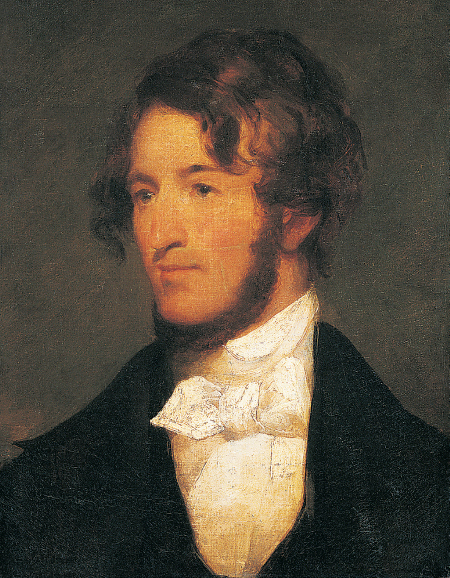America’s History: Printed Page 346
America: A Concise History: Printed Page 315
America’s History: Value Edition: Printed Page 307
Ralph Waldo Emerson and Transcendentalism
Emerson was the leading voice of transcendentalism, an intellectual movement rooted in the religious soil of New England. Its first advocates were Unitarian ministers from well-to-do New England families who questioned the constraints of their Puritan heritage. For inspiration, they turned to European romanticism, a new conception of self and society. Romantic thinkers, such as German philosopher Immanuel Kant and English poet Samuel Taylor Coleridge, rejected the ordered, rational world of the eighteenth-century Enlightenment. They embraced human passion and sought deeper insight into the mysteries of existence. By tapping their intuitive powers, the young Unitarians believed, people could come to know the infinite and the eternal.

As a Unitarian, Emerson stood outside the mainstream of American Protestantism. Unlike most Christians, Unitarians believed that God was a single being, not a trinity of Father, Son, and Holy Spirit. In 1832, Emerson took a more radical step by resigning his Boston pulpit and rejecting all organized religion. He moved to Concord, Massachusetts, and wrote influential essays probing what he called “the infinitude of the private man,” the radically free person.
The young philosopher argued that people were trapped by inherited customs and institutions. They wore the ideas of earlier times — New England Calvinism, for example — as a kind of “faded masquerade,” and they needed to shed those values. “What is a man born for but to be a Reformer, a Remaker of what man has made?” Emerson asked. In his view, individuals could be remade only by discovering their “original relation with Nature” and entering into a mystical union with the “currents of Universal Being.” The ideal setting for this transcendent discovery was under an open sky, in solitary communion with nature. The revivalist Charles Grandison Finney described his religious conversion in Emersonian terms: an individual in the woods, alone, joining with God in a mystical union.
The transcendentalist message of individual self-realization reached hundreds of thousands of people through Emerson’s writings and lectures. Public lectures had become a spectacularly successful way of spreading information and fostering discussion among the middle classes. Beginning in 1826, the lyceum movement — modeled on the public forum of the ancient Greek philosopher Aristotle — arranged lecture tours by hundreds of poets, preachers, scientists, and reformers. The lyceum became an important cultural institution in the North and Midwest, but not in the South, where the middle class was smaller and popular education had a lower priority. In 1839, nearly 150 lyceums in Massachusetts invited lecturers to address more than 33,000 subscribers. Emerson was the most popular speaker, eventually delivering fifteen hundred lectures in more than three hundred towns in twenty states.
Emerson celebrated those who rejected tradition and practiced self-discipline and civic responsibility. His individualistic ethos spoke directly to the experiences of many middle-class Americans, who had left family farms to make their way in the urban world. His pantheistic view of nature — that it was saturated with the presence of God — encouraged Unitarians in Boston to create the Mount Auburn Cemetery, a beautiful planned landscape of trees and bushes and burial markers for the dead of all faiths; soon there were similar rural cemeteries in many American cities. Emerson’s optimism also inspired many religious preachers of the Second Great Awakening, such as Finney, who told believers to transcend old doctrines and constraints. “God has made man a moral free agent,” Finney declared.
Emerson worried that the new market society — the focus on work, profits, and consumption — was debasing Americans’ spiritual lives. “Things are in the saddle,” he wrote, “and ride mankind.” Seeking to revive intellectual life, transcendentalists created communal experiments. The most important was Brook Farm, just outside Boston, where Emerson, Henry David Thoreau, and Margaret Fuller were residents or frequent visitors. Members recalled that they “inspired the young with a passion for study, and the middle-aged with deference and admiration.” Whatever its intellectual excitement and spiritual rewards, Brook Farm was an economic failure. The residents planned to produce their own food and exchange their surplus milk, vegetables, and hay for manufactures. However, most members were ministers, teachers, writers, and students who had few farming skills; only the cash of affluent residents kept the enterprise afloat for five years. After a devastating fire in 1846, the organizers disbanded the community and sold the farm.
With the failure of Brook Farm, the Emersonians abandoned their quest for new social institutions. They accepted the brute reality of the emergent commercial and industrial order and tried to reform it, especially through the education of workers and the movement to abolish slavery.
UNDERSTAND POINTS OF VIEW
Question
What were the main principles of transcendentalism, and how did they differ from the beliefs of most Protestant Christians?